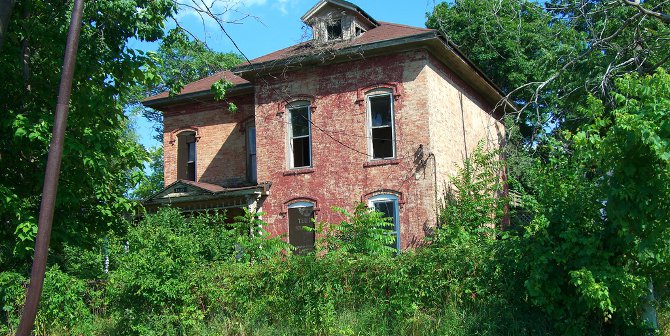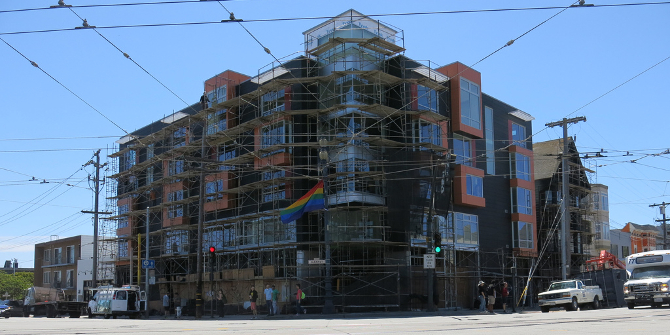 Can produce gardens make a difference to communities in former industrial cities? Allison M Krusky took part in a program in Flint, Michigan, which catalogued urban blight as well as community gardens. She finds that residents who lived within 100 meters of a produce garden were much more likely to better maintain their yards compared to those close to vacant, overgrown lots. Given that homeowners tend to replicate the landscaping decisions of their neighbors, she argues that encouraging produce gardens could be a way to tackle urban blight in cities such as Flint.
Can produce gardens make a difference to communities in former industrial cities? Allison M Krusky took part in a program in Flint, Michigan, which catalogued urban blight as well as community gardens. She finds that residents who lived within 100 meters of a produce garden were much more likely to better maintain their yards compared to those close to vacant, overgrown lots. Given that homeowners tend to replicate the landscaping decisions of their neighbors, she argues that encouraging produce gardens could be a way to tackle urban blight in cities such as Flint.
The weather is warming up and the change in season heralds the beginning of the gardening season. Hanging flower baskets and potted plants begin appearing nearby businesses, homes, flats and along the downtown streets. The grey cement and skies of the winter are being overtaken by vibrant green trees and multicolored flowers. For cities that have been hit hard by the economic recession, the hardiest perennials continue to re-emerge even if the person who planted them is long gone. How can we breathe life into our communities? The answer may be in a bag of seeds.
The city of Flint, Michigan, is considered part of the rust belt; a region marked by drastic population loss within cities that once boomed with automotive and industrial blue collar work. Some of these cities once contained hundreds of thousands of people. But large masses of citizens began moving out of the cities for the suburbs and in search of work. Flint has lost roughly half of its population since its peak in the 1960s. With an increasing number of abandoned homes and properties, the Genesee County Land Bank, which includes the city of Flint, was created to alleviate the burden of caring for these properties from a financially-stretched city.
The Genesee County Land Bank has several blight reduction programs. One of these is the Clean and Green program in which community organizations maintain a minimum of 25 properties. The center I work for, The Michigan Youth Violence Prevention Center (MI-YVPC) partnered with the Land Bank to improve blighted neighborhoods. MI-YVPC evaluated the physical environment using property assessments. Each summer, six property assessors walk down hundreds of streets to identify signs of blight and upkeep in more than 10,000 properties. Many of the streets are full of homes, but no people. Roughly 60 percent of the residential properties surveyed had no signs of life and undeveloped lots had grass higher than the waist by mid-summer.
From the street, property assessors scan for litter or trash, and assess the maintenance of the lawn and landscaping. They are trained to evaluate the condition of a home by identifying broken siding, peeling paint and holes in the roof. Intermingled within these neighborhoods are vibrant gardens full of life. These gardens are not your run-of-the-mill family flower gardens. They encompass more than half of the property and are filled with rows of produce ranging from tomatoes and peppers to berries and melons. These gardens are a visual oasis compared to the many vacant, undeveloped and overgrown lots spotting the neighborhoods. Some are community gardens, and others are owned by the person next door. The large size and vulnerability of the crops indicates that these gardens need and receive a lot of care.

The level of attention these gardens receive is the opposite of abandoned, undeveloped lots. The homes close to gardens follow a similar pattern. Residents who lived within 50m of a produce garden showed better maintenance of their yards compared to people in the same neighborhood who were close to an undeveloped, vacant property. These yards had frequent mowing, well-tended landscaping and less litter and trash compared to those near the vacant lots. Better yard maintenance was also seen in homes within 100m of the produce gardens. There is a noticeable difference in the level of care of homes nearby produce gardens.
The next time you step outside on a summer day look around your neighborhood. As you admire the newly planted greenery and the blooming of previous years’ hard work, take a moment and absorb the surrounding scenery. Do you notice the same flowers on neighboring properties? Or perhaps the neighbors facing one another have the same bushes by their driveway? Chances are that you’ll see small clusters of similar greenery. These are not plants that have traveled by wind, rain or animals. These are flowers, bushes or trees planted by a person.
Homeowners tend to replicate the landscaping decisions of their neighbors, in particular neighbors within sight of the home. This phenomenon of neighbors copying landscaping is called landscape replication or landscape mimicry. Perhaps neighbors exchange plants and tips for what to grow or maybe homeowners are inspired by the creative landscaping of the person next door. We like to describe this process as the “greening hypothesis.” As one or two households begin caring for, or greening, their lawn and landscaping, others begin to follow suit.
Most people enjoy looking at well maintained lawns, and if you are the owner of one of these properties you may have a few admirers! These homeowners are viewed as hard-working and good neighbors. Other neighbors may want to keep up with the Joneses, especially if the yard represents a prestigious way of living. And how many times have you groaned because the neighbors are trimming the bushes or mowing their lawn? Now you have to go outside and clean up! There are exceptions of course, but most people want their property to either fit in with the neighborhood or look better than the others.
Although personal preference is the driving factor for what the homeowner chooses to do with their yard; neighborhood factors do come into play. One characteristic is how tightly bonded neighbors are with one another. Neighborhoods where residents reported being empowered and trusting of their neighbors had higher yard maintenance that those reporting less. In neighborhoods with strong bonds, those homes had even better maintenance if they were near a produce garden.
The city of Flint and other former industrial cities are working to rebuild after a historic economic decline. There is no doubt that fighting urban blight will take time and plenty of resources. Yet even in some of the hardest hit neighborhoods there are residents who continue to beautify their neighborhoods. They make the decision to create life and beauty in the form of a produce garden. In time, hopefully our cities will also see the fruits of hard labor to remove urban blight and revitalize our communities.
This article is based on the paper ‘The effects of produce gardens on neighborhoods: A test of the greening hypothesis in a post-industrial city’, in Landscape and Urban Planning.
Please read our comments policy before commenting.
Note: This article gives the views of the authors, and not the position of USApp– American Politics and Policy, nor of the London School of Economics.
Shortened URL for this post: http://bit.ly/1DMXzVd
_________________________
 Allison Krusky – University of Michigan
Allison Krusky – University of Michigan
Allison Krusky is a Research Associate at the University of Michigan School of Public Health. Her research interests include evaluation, health equity, positive youth and community development.







Just as blight creates a downward spiral in some neighborhoods, especially in legacy cities like Flint, blight elimination and property improvements can create upward spirals in those same neighborhoods. It’s great of you to highlight the hard work of residents who take pride in their homes and try to bring their neighborhoods back. Thank you!